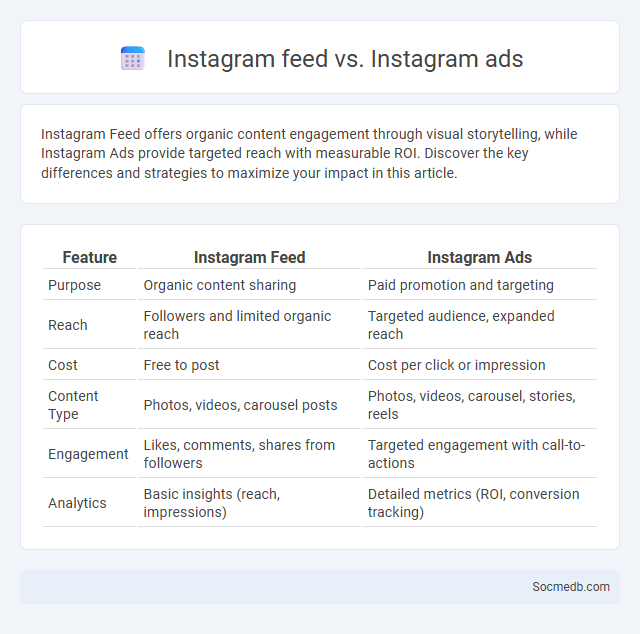
Photo illustration: Instagram Feed vs Instagram Ads
Instagram Feed offers organic content engagement through visual storytelling, while Instagram Ads provide targeted reach with measurable ROI. Discover the key differences and strategies to maximize your impact in this article.
Table of Comparison
| Feature | Instagram Feed | Instagram Ads |
|---|---|---|
| Purpose | Organic content sharing | Paid promotion and targeting |
| Reach | Followers and limited organic reach | Targeted audience, expanded reach |
| Cost | Free to post | Cost per click or impression |
| Content Type | Photos, videos, carousel posts | Photos, videos, carousel, stories, reels |
| Engagement | Likes, comments, shares from followers | Targeted engagement with call-to-actions |
| Analytics | Basic insights (reach, impressions) | Detailed metrics (ROI, conversion tracking) |
Understanding Instagram Feed: Definition and Features
Instagram Feed is a dynamic collection of photos and videos shared by accounts you follow, designed to keep you updated with the latest content. Features include a chronological and algorithm-driven timeline, Stories highlights, Reels integration, and interactive elements like likes, comments, and direct messages, enhancing user engagement. Understanding these components helps you optimize your content strategy and connect effectively with your audience on Instagram.
What Are Instagram Ads? Key Characteristics
Instagram ads are paid promotional content designed to reach your target audience within the Instagram app, leveraging photo, video, carousel, and story formats. These ads are characterized by advanced targeting options including demographic, interest, and behavior-based criteria, ensuring your message connects with potential customers. Your campaign's success depends on the platform's powerful analytics tools that track engagement, impressions, and conversions for optimized ad performance.
Instagram Feed vs Instagram Ads: Core Differences
Instagram Feed showcases organic content from accounts you follow, emphasizing authentic engagement and community building through posts and stories. Instagram Ads leverage targeted algorithms and paid placements to reach specific audiences beyond your followers, optimizing exposure and conversion rates. Understanding these core differences helps you balance genuine interactions with strategic growth on the platform.
User Engagement: Feed Content vs Sponsored Content
User engagement on social media significantly differs between feed content and sponsored content, with organic feed posts typically driving higher interaction rates due to their authentic and relatable nature. Sponsored content often faces skepticism, but strategic targeting and creative execution can enhance its effectiveness by aligning ads with users' interests and behaviors. Understanding the balance between these content types helps you optimize campaign performance and maximize your audience's engagement.
Organic Reach: Feed Advantages and Limitations
Organic reach on social media refers to the number of unique users who see a brand's content without paid promotion, primarily appearing in their news feed. The advantages include increased audience trust and engagement due to perceived authenticity, as well as cost-effectiveness since there are no advertising expenses. Limitations involve restricted visibility due to algorithmic prioritization, resulting in lower reach compared to paid ads, and the challenge of consistently creating high-quality content that resonates with the target audience.
Targeting and Personalization with Instagram Ads
Instagram Ads leverage advanced targeting options such as demographic data, interests, behaviors, and location to reach precise audience segments. Personalized ad content, including dynamic creatives and tailored messaging, enhances user engagement and conversion rates. Utilizing Instagram's algorithm for retargeting allows businesses to reconnect with users who have interacted with their brand, maximizing ad relevance and ROI.
Content Strategies: Feed Posting vs Paid Campaigns
Effective content strategies on social media involve balancing organic feed posting with paid campaigns to maximize reach and engagement. Feed posting builds authentic connections through consistent, value-driven content tailored to your audience's interests, while paid campaigns provide targeted exposure and measurable ROI by leveraging advanced demographic and behavioral data. Your success depends on integrating both approaches, using analytics to refine organic posts and optimize ad spend for sustained growth.
Cost Implications: Natural Feed vs Advertising Spend
Social media platforms present a significant cost divergence between natural feed reach and advertising spend, with organic posts typically requiring minimal financial investment but often delivering limited audience engagement and slower growth. In contrast, paid social media advertising demands substantial budget allocations yet offers precise targeting options and scalable reach, resulting in higher conversion rates and measurable ROI. Businesses must balance organic content strategies with strategic ad spend to optimize cost efficiency and maximize overall social media impact.
Conversion Rates: Analyzing Feed Results vs Ad Performance
Social media conversion rates vary significantly between organic feed results and paid ad performance, with ads typically driving higher engagement due to targeted audience segmentation. Your campaign's success depends on analyzing key metrics such as click-through rates, cost per acquisition, and overall return on investment to optimize ad spend effectively. Understanding these data points helps refine strategies, ensuring your content resonates both organically and through paid promotions for maximum conversions.
Choosing the Right Approach: Feed, Ads, or Both?
Choosing the right social media approach depends on Your business goals and target audience behavior. Organic feed posts build authentic engagement and long-term relationships, while paid ads deliver precise targeting and immediate visibility. Combining both strategies maximizes reach and effectiveness, ensuring consistent brand presence and optimized campaign performance.
 socmedb.com
socmedb.com